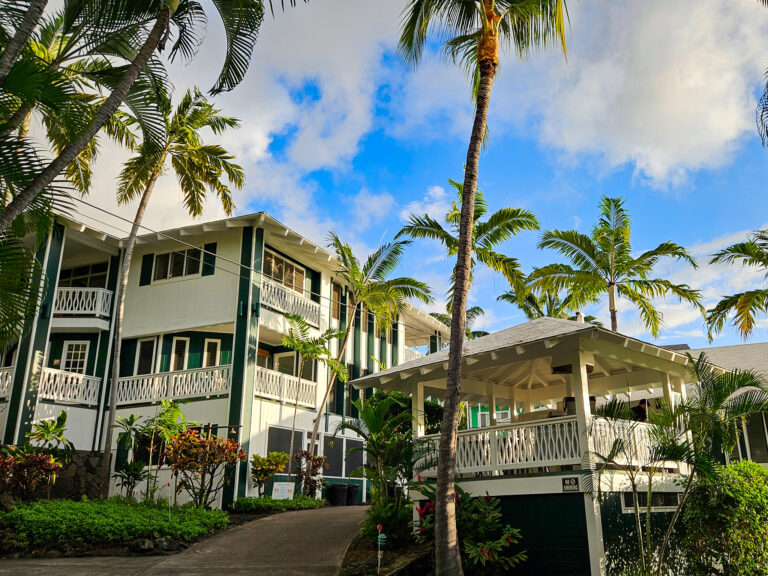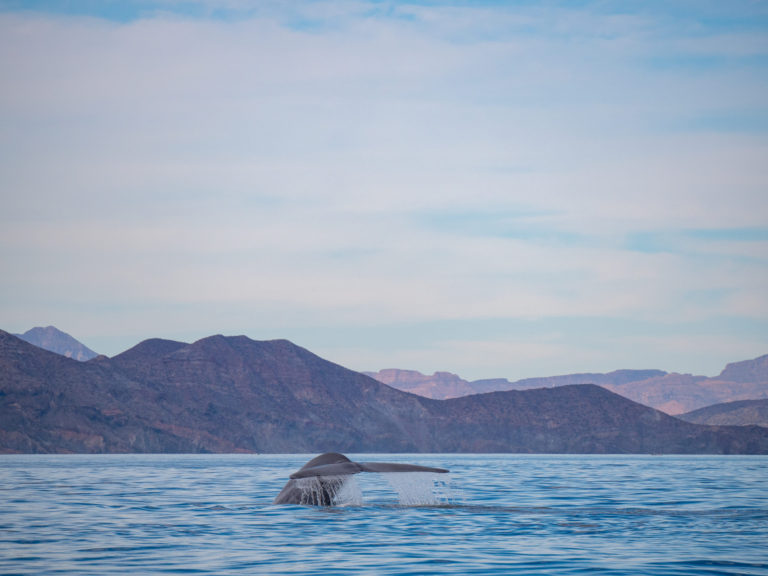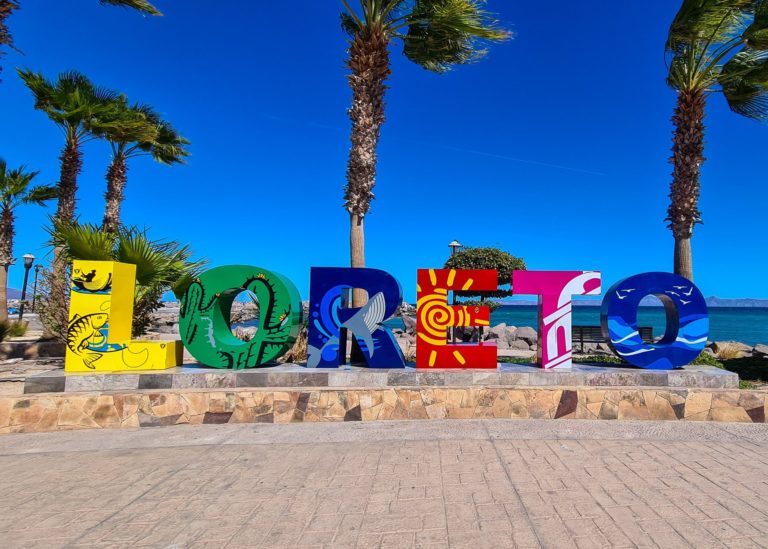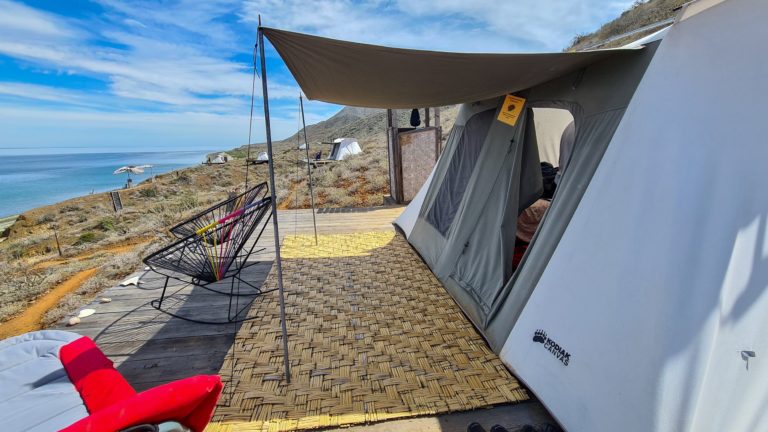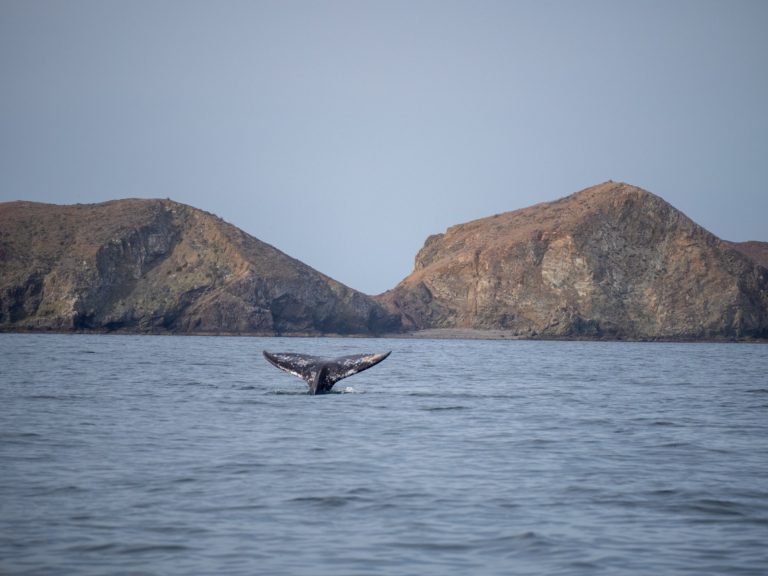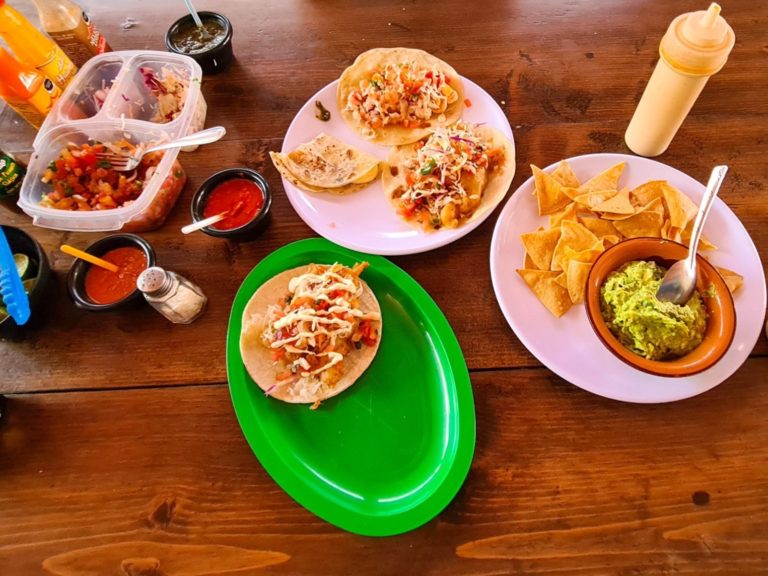The Thorough Guide to Hilo
The 19 Best Things to do in Hilo, Hawai’i, how to get here, what to eat, where to stay, interactive map and more!
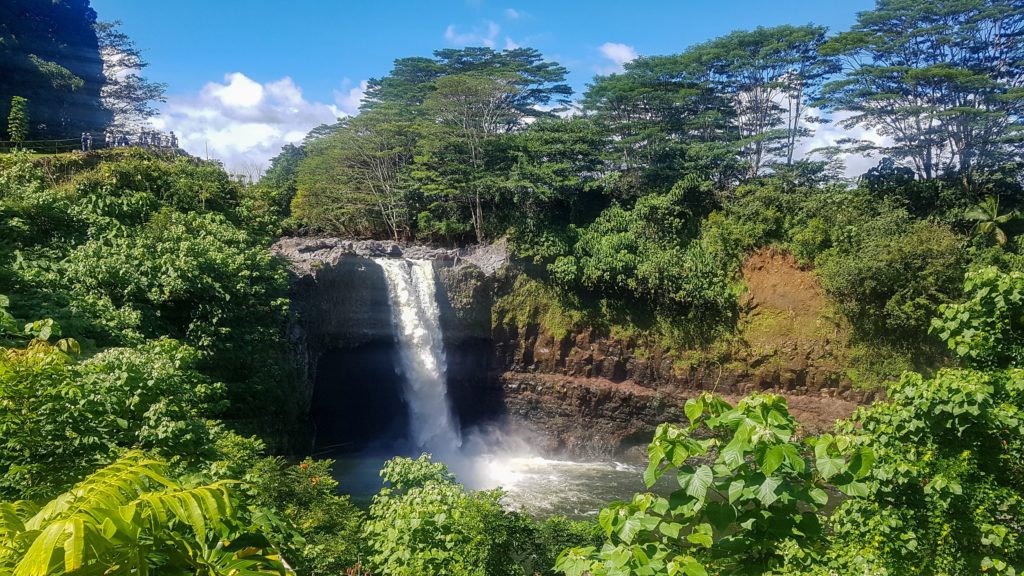
This post may contain affiliate links, which means we might earn a small commission on anything purchased through these links at no extra cost to you. Learn more on our disclaimer page.
Hilo, on the east coast of Hawai’i, is a haven of tropical rainforests, coastal views, black sand beaches and volcanic landscapes. The town itself is a vibrant mix of art galleries, shops, restaurants, and features the beautiful Liliuokalani Park and Gardens, as well as a tropical zoo. The climate is tropical and much more humid than the rest of the island, but if and when it does rain, it doesn’t last for long. It’s this specific climate that makes Hilo the lushest place in Hawaii.
Time needed: 3-5 days.
When to go: September-November – off-peak means fewer crowds, cheaper prices and the weather is still great.
Weather: Consistently between 18°C-28°C with a humid, tropical climate. Showers are frequent but don’t last long, while November-March sees slightly less rain.
Language: English & Hawaiian.
Currency: American Dollar.

Things to do in Hilo
1) Stargaze on top of Mauna Kea
Mauna Kea is a dormant volcano on Hawaii’s Big Island. Due to the height and the lack of light pollution – the peak is 4,207.3 metres (13803ft) above sea level (which is nearly double the elevation of Machu Picchu!), it is one of the best places in the world to see the stars. The summit is home to a telescope observing centre and is the highest point in the state of Hawaii and second-highest peak of an island on Earth. While you can’t explore the telescopes as a tourist, you can book onto an night-time guided stargazing tour, which will take you up Mauna Kea and show you all the constellations.
Some tours stop at the Visitor Centre for dinner to allow you to acclimatise, as getting used to the altitude takes a little time. But, due to the reduced atmosphere, thousands more stars are visible to the naked eye than at sea level. Stars actually burn at a range of colours, which are more apparent at a higher altitude – you may even be able to see blue, green and red in Orion’s Belt. If you need transportation included in your tour, consider this highly-rated Mauna Kea Summit Sunset and Stars Tour With Free Astro Photos.
Dan was actually sent up Mauna Kea on a work trip, where he observed the stars from the James Clerk Maxwell Telescope (JCMT), the largest single-dish telescope that operates in submillimetre wavelengths.

2) Waiānuenue Falls
Waiānuenue Falls, also aptly known as Rainbow Falls due to the rainbows that dance in the splash of the waterfall, is a short drive or less than an hour’s hike from Hilo. It features a small car park, short trail and two lookouts, as well as lots of beautiful Banyan trees. It’s a pretty popular spot and can get busy as a lot of tours stop here too so we’d recommend timing your visit with early morning or late evening to avoid the crowds.

3) Pe’epe’e
Just up the river from Rainbow Falls lies Pe’epe’e. Featuring a whirlpool and picturesque Pe’epe’e Falls, this area is also known as Boiling Pots. This spot is apparently where Maui chased the giant lizard Mo’o Kuna after saving his mother, Hina. As the Hawaiian mo‘olelo (story) goes, Mo‘o Kuna was trying to drown Hina when Maui chased him from Rainbow Falls, upstream to the pools just below the Boiling Pots viewpoint. Maui couldn’t get a good shot at the mo‘o, who was hiding in the potholes, so he called upon Pele, the goddess of fire, who gave Maui hot stones to throw in the river. The hot stones made the river boil, which drove Kuna from his refuge. The river still bubbles as if it’s boiling today, but scientists say the pools were actually formed by the slow cooling of basalt lava – you decide.
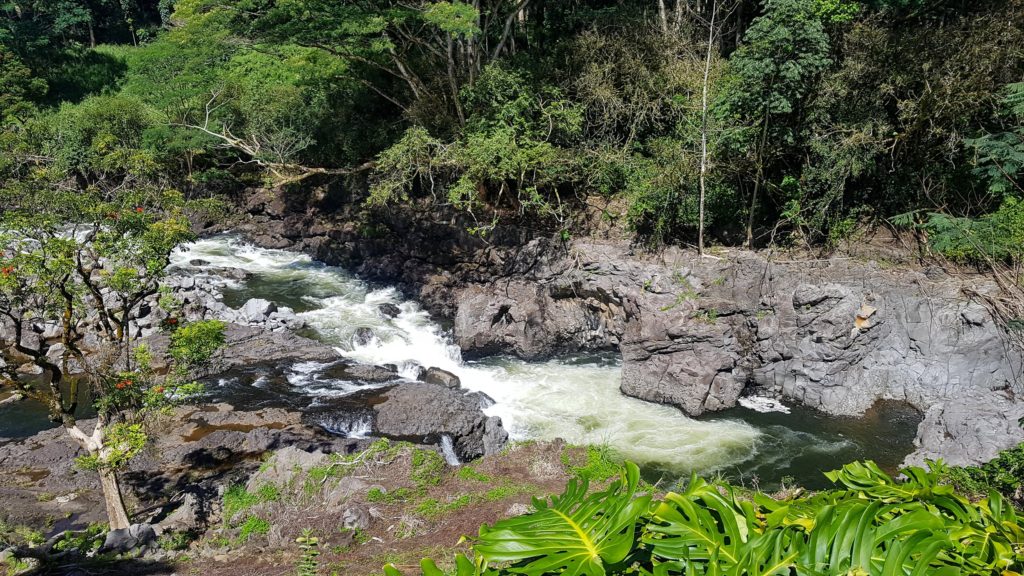
4) Wailuku River
As you follow the Wailuku River upstream you lose the crowds entirely. On the lower part of the river lies the Wailuku River State Park, which is very popular for swimming. But beware, Wailuku River accounts for 25% of the river drowning deaths in the state, so if you do plan to swim do your research and be very careful.
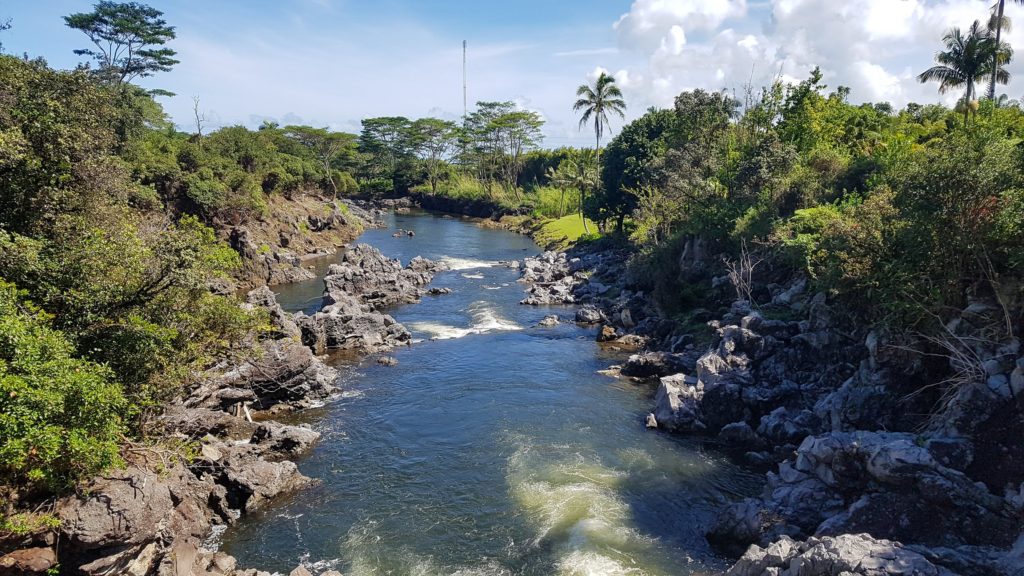
5) Wai’ale Falls
Follow Waianuenue Ave upstream until you get to a bridge. This spot is home to Wai’ale Falls. There’s a nice little walk here which you can follow from the north side of the bridge to the falls and you can park just off the road once across the bridge.

6) Old Mamalahoa Highway
Old Mamalahoa Highway, also known as the scenic road, is one of our favourite drives on Big Island. The 4 mile route winds along the coast and passes through lush jungle. There are several attractions, trails and scenic lookouts along the way, including the Hawaii Tropical Bioreserve & Garden and Onomea Bay. Keep an eye out for wildlife – we spotted several Indian Mongooses.

7) Hawai‘i Tropical Bioreserve & Garden
A short drive north of Hilo, Hawai‘i Tropical Bioreserve & Garden is a non-profit botanical garden and nature bioreserve. It is home to over 2000 plant species and represents more than 125 families and 750 genera of tropical exotics. Entry is $25 per adult, but as it is a non-profit organisation, all money goes back into the upkeep of the bioreserve. The Garden is very popular with photographers, gardeners, scientists, and nature lovers and is home to a variety of animals and birds.
Pro-tip: You can actually see some of the gardens for free! Check out our next point to find out how.

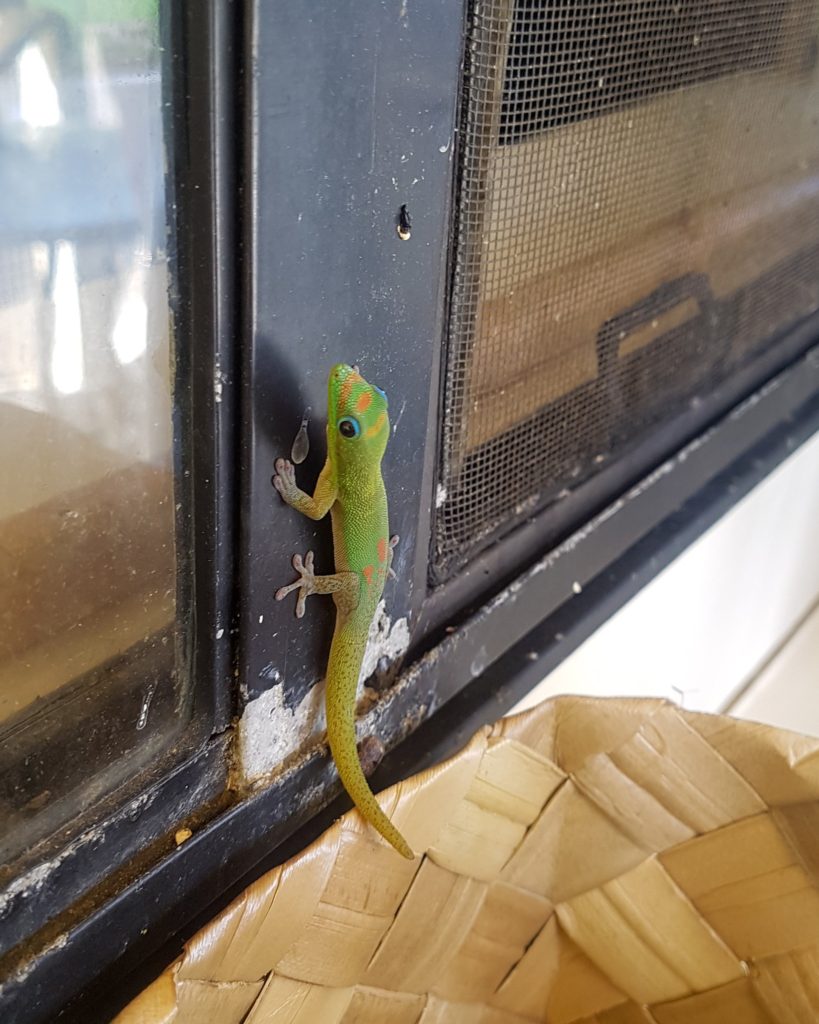
8) Onomea Bay
Onomea Bay is a small rocky shore and the site of an ancient coastal fishing village, located in one of the lushest areas on Big Island. There are two trails that you can take from the road to the bay: The Onomea Bay Trail and The Old Donkey Trail.
At the start of both trails there are large dirt patches big enough for 2-3 cars where you can park for free, just make sure you’re pulled completely off the road. Don’t park at the Garden as it’s only free for customers.
For the Onomea Bay Trail, follow the road that veers off towards the sea down a steep decline. This route follows the alignment of the Old Government Road into the Hawai‘i Tropical Bioreserve & Garden, which you can walk through part of for free so long as you stick to the path towards the bay! After a short detour along Alakahi Stream you’ll arrive at the bay and be met with a rocky shore, coconut trees and the site of an ancient coastal fishing village.
For the Old Donkey Trail, named because it actually was a trail for donkeys packing cargo from Onomea bay, follow the path from the small brown sign, just after the Garden. This will take you through jungle to Onomea stream and the bay.

9) Akaka Falls State Park
A short drive from Hilo, entering Akaka State Falls is like stepping onto the Avatar planet Pandora. Full of lush tropical vegetation, streams and waterfalls, the park features a 0.4-mile loop footpath allowing you to explore at your own pace. It is paved, but involves steps, and offers multiple scenic vista points, which overlook the park, as well as the cascading Kahuna Falls and the free-falling Akaka Falls. The incredible Akaka Falls is 135 metres (442 ft) tall – that’s nearly 3 times the height of Canada’s Niagara Falls – and free-falls into a stream-eroded gorge. The park is open daily between 8:00 and 17:00 and there’s a fee for non-residents of $5 per person, plus a $10 parking fee. If you don’t hire a car, you can visit Hilo’s majestic waterfalls with a local guide.
Pro-tip: Find a space to park along the road outside of the gates where parking is free!


10) Zipline over KoleKole Falls
Down the road from Akaka State Falls, you can zipline through Hilo’s lush forests over the 76 metre (250ft) tall KoleKole Falls. The 7-line zipline course offers panoramic views of mountains, the renowned Hamakua Coast and dense rainforest, from one of the longest ziplines in the US.
11) Volcano Winery
Tucked between the two volcanoes Mauna Loa and Kilauea, Hawaii’s Volcano Winery is located one mile from the Volcanoes National Park and is America’s southernmost winery. Their award-winning wines are unique as the grapes are grown in volcanic soil and are only produced on the Big Island. They produce a range of delicious estate teas too. You can pop in for a browse or join in on a super affordable tasting of their wines or teas.
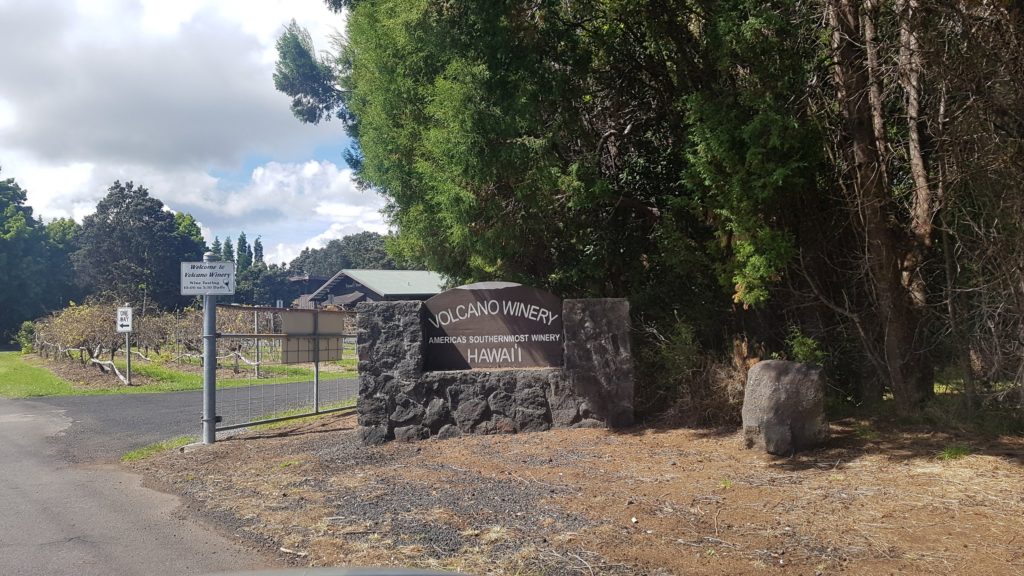
12) Volcanoes National Park
Hawaii Volcanoes National Park stretches from the summit of active volcanos Mauna Loa and Kīlauea, to the ocean. It is a 335,259 acre (about 523 square mile) area full of steaming vents, giant craters, fields of petrified lava and, if you visit during an eruption, spewing and flowing lava too.
You can drive the circular 10.6 mile Crater Rim Drive, which circumnavigates the Kilauea Caldera and passes sulphur banks, steam vents and lava tubes, as well as the Halemaumau Crater, which is said to be the home of Pele, the volcano goddess. Then, you can take the Chain of Craters Road south through fields of petrified lava to the Hōlei Sea Arch. This route passes multiple trails and lookouts so you should stop often to admire the view and see the basalt up close. Be careful though, petrified lava is as sharp as broken glass! If you’re driving, you should consider buying a Virtual Self-drive Tour, which provides hours of informative audio commentary, stories and legends about Volcanoes National Park.
If you don’t have your own transport, this highly-rated, small group day tour from Hilo visits all the main sights in Volcanoes National Park with a knowledgeable local guide. You’ll not only visit Halemaumau crater and learn about the history and legends of the park, but you’ll have time in Hilo itself too, visiting Liliuokalani Gardens, Rainbow Falls and tasting local coffee and Big Island treats at a chocolate factory.
Read next: Everything you need to know about visiting Hawai’i Volcanoes National Park

13) See spewing lava
If your visits coincides with a volcanic eruption you should research where is best within the park to see the lava flow. You can join a guided hike or e-bike tour to get up close to this natural phenomenon and learn more about Hawaii’s volcanic landscape. Tours that visit after dark showcase the most dramatic display of spewing lava against the night sky.
One of the best things to do in Hawaii is to see the scenery from the air. You can take a Helicopter Flight over Hawaii Volcanoes National Park, which gives you a bird’s eye view of Mauna Kea and Mauna Loa volcanos. You’ll witness calderas, volcanic cones and vast petrified lava fields and, if your visit coincides with an eruption, you can see flowing lava too!

14) Kaumana Cave
Situated not far from Hilo in Kaumana Cave State Park, Kaumana Cave is a lava tube that visitors can descend into and explore. It was created by the 1881 lava flow from Mauna Loa and is said to be 2.026 miles (3km) long, making it the 57th longest lava tube in the world. You can park on the south side of Hwy. 200 and cross to the north side to enter. Make sure you wear sturdy shoes and take a torch. You can explore a short way in both directions before the lava tube enters private property.

15) Chill on the beach
Hilo is not known for its beaches and a few can be quite hazardous, but it also has some beautiful coves and protected water for swimming and snorkelling. Unlike the west side of the island which has sweeping flats of golden sands, the east side of the island offers volcanic black sand beaches and dramatic basalt shores. Our two favourite safe-swimming beaches in Hilo are Carlsmith Beach Park and Richardson Ocean Park, which are both the best beaches to spot a turtle in too!

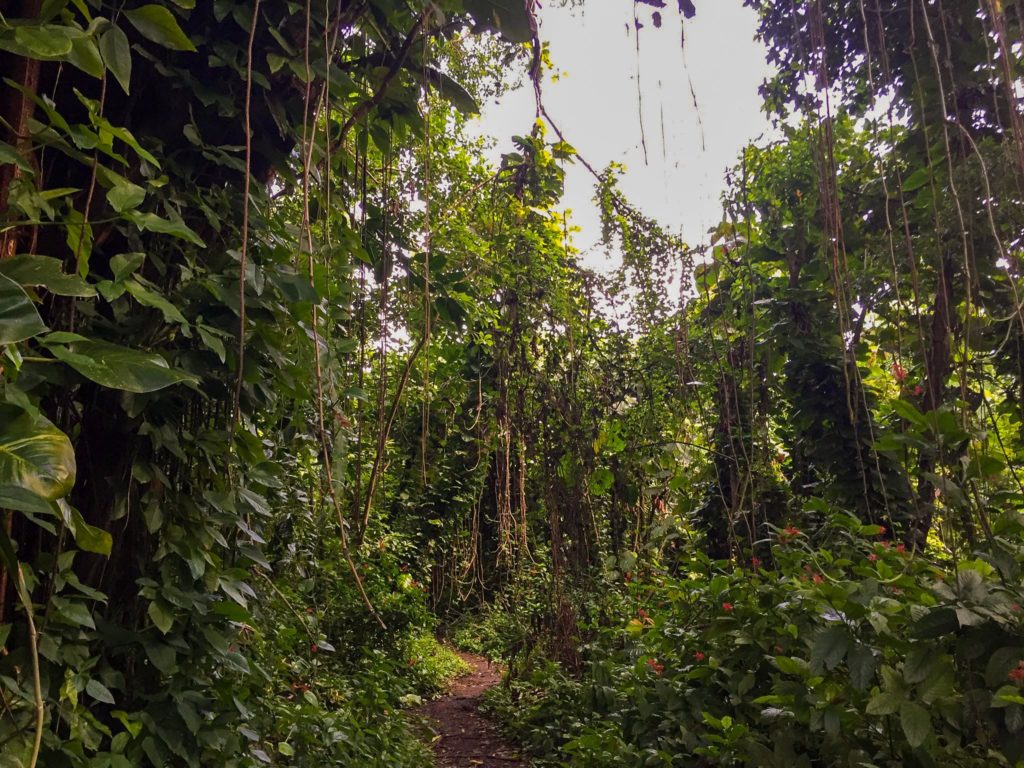
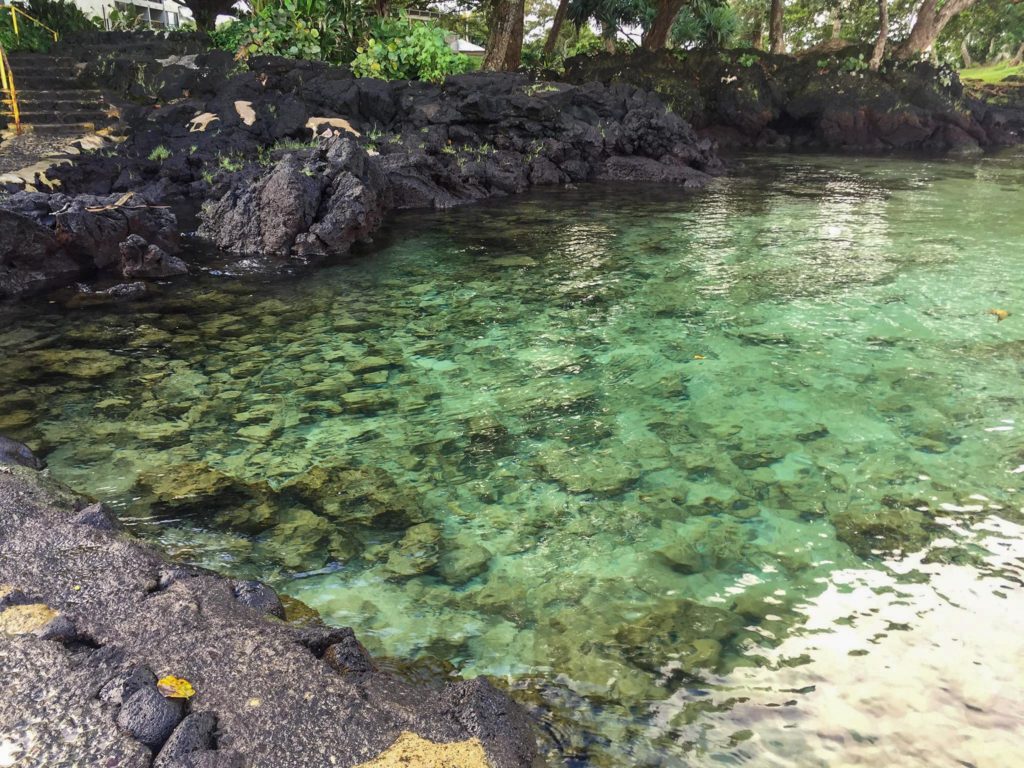
16) Swim with turtles
Speaking of turtles, Hilo is one of the best spots on the island for spotting these cute little reptiles. Known by Hawaiians as Honu, there are three species of sea turtles found around Big Island: Green, Hawksbill, and Leatherback. If you’re lucky enough to come across one on the beach or in the sea, remember to stay at least 3 metres (10 feet) away and never chase or touch a turtle. There is a fine for harassing or touching a sea turtle of $1,000 to $10,500.
You can join a Small-group Guided Snorkel Tour to safely swim with turtles, without harming them. Hilo Ocean Adventures is a local family-owned company with a mission to protect, sustain and embrace the aina (Hawaii’s land).
Read next: Ethical Wildlife Tourism in Hawaii

17) Go SCUBA diving
While the west side of Big Island might be prolific for snorkelling and diving, Hilo offers a unique setting of volcanic beaches that is magical to SCUBA dive. Hilo Ocean Adventures are Hilo’s only fully equipped ocean adventure company and offer a variety of SCUBA diving packages, from 1-tank dives to night dives. We’d recommend making the most of your day and booking a 2-tank dive, where you can see wildlife including sea turtles, octopus, manta rays, eels, tropical reef fish and dolphins.

18) Spot dolphins on a snorkel trip
Don’t worry if you’re not SCUBA certified, there’s still plenty of opportunity to get into Hawaii’s warm waters and discover a world of underwater life. You can join a Guided Snorkel Tour, where you can snorkel in pristine waters on a colourful coral reef. On the way to and from your snorkel spot, you’ll keep an eye out for dolphins and hopefully see up to hundreds of spinner dolphins playing around your boat.
Read next: The Thorough Guide to Snorkelling on Hawaii’s Big Island

19) Go whale watching
Humpback whales migrate all the way from Alaska to Hawaii every year between November and April. Witnessing Hilo’s gentle giants with views of the Mauna Kea Volcano is a bucket list experience. On this Small-group whale Whale Watching Tour, you will cruise along the Hamakua Coast in search of humpback whales and spinner dolphins.
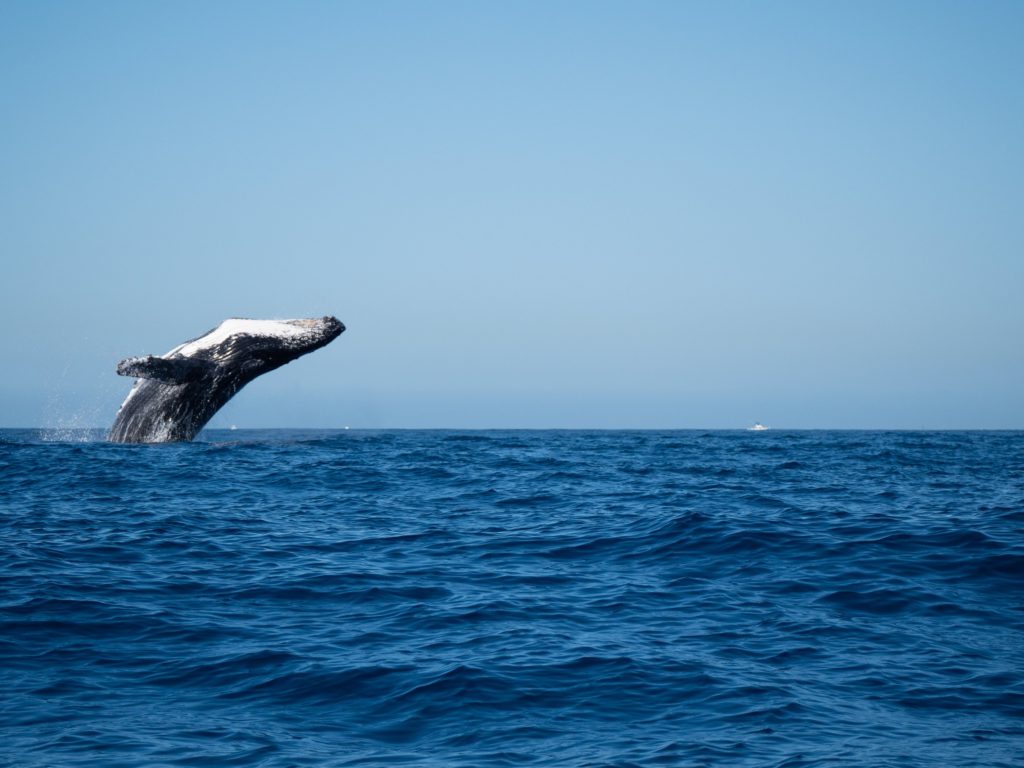
Interactive Hawaii Big Island Map
Use the tab in the top left corner to filter things to do, places to eat, accommodation and more!
Where to Eat in Hilo
Here are a few of our favourite restaurants and cafés in Hilo:
What’s Shakin’ – A cute outdoor café between Hilo and Akaka Falls, it specialises in homegrown produce and fruit smoothies. Try the fresh coconuts and taro wraps!
Suisan Fish Market – Sells fresh, locally caught fish and salad bar. Make your own poke (raw fish) bowl!
Ponds Hilo – A sports bar offering American cuisine with views of ice & koi ponds, plus often features live music.


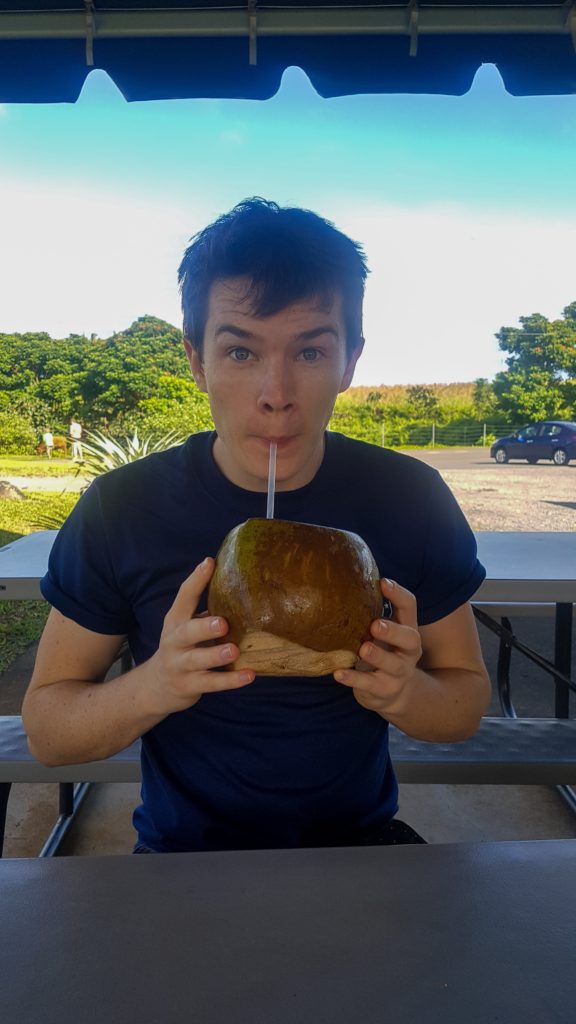
Volcano Garden Arts’ Café Ono – A mile from Hawai’i Volcanoes National Park, featuring an art gallery and greenhouses, with access to nature trails and Japanese gardens. A selection of vegan friendly soups, sandwiches, salads and small meals.
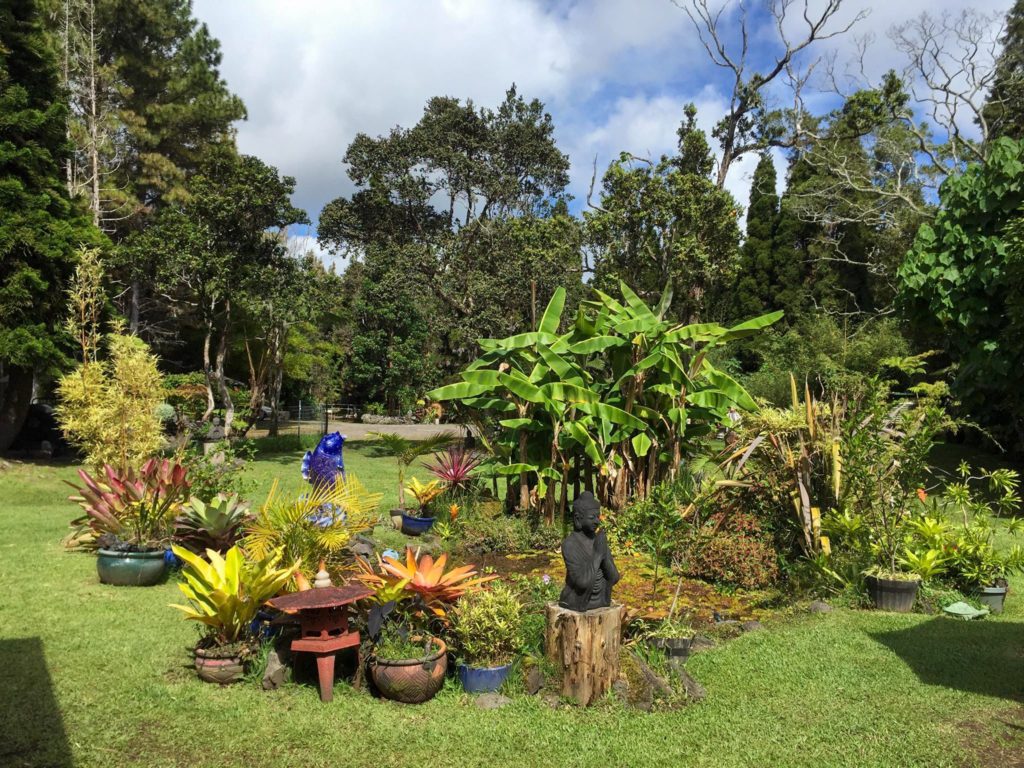
Mohala’s Bayfront Fish and Chips – Known locally as Mo’s, enjoy fresh catch of the day with chips and veggie sides.
Ken’s House of Pancakes – A favourite of Dwayne ‘The Rock’ Johnson, this diner features American food with a Hawaiian twist. Get a nacho salad bowl, root beer ice cream float and, of course, the famous buttermilk pancakes.


Where to Stay in Hilo
Budget: Hilo Bay Hostel – An affordable hostel featuring dorm rooms with bunks, ceiling fans and free lockers, as well as a communal lobby-lounge area with a TV and DVD player, Internet stations and free Wi-Fi. There is also a kitchen, patio garden and coin-operated laundry facilities, and complimentary tea and coffee. Parking is free and Island-themed private rooms come with room for bikes and surfboards, while some upgraded rooms have en-suite bathrooms.
Mid-range: Hilo Reeds Bay Hotel – A 2-minute walk from Reed’s Bay Beach Park, this chill hotel features free Wi-Fi, TV, kitchenettes with minifridges, microwaves and coffeemakers. Some rooms have balconies, with stunning ocean views. There is an outdoor pool with bay views, guest laundry facilities and parking is free.
Luxury: Grand Naniloa Hotel Hilo – a DoubleTree by Hilton – A modern, ocean-front hotel that features mini-fridges, coffeemakers, flat-screen TVs, and Wi-Fi, while suites have a kitchenette and separate sitting area. The hotel also has a 9-hole golf course, outdoor pool and a sun deck, plus meeting and event space. Parking and coin-operated laundry facilities are available.

How to Get Around Hawaii Big Island from Hilo
While it is possible to navigate Big Island via taxi and public transport, we would strongly recommend you hire a car. There is quite a range of companies who serve Hilo, including Hertz, Alamo, Thrifty, Budget, who all have an office at Hilo International Airport. The website Discount Hawaii Car Rental is really great for comparing car rental prices but we’d also recommend booking direct if you can so you have correspondence directly with the office. Another advantage of booking with an established agency is that you can pick up the car from one destination and return it to any other one of their offices. This is what we did on our trip – we picked up at Hilo airport and returned to Kona airport a week later.
If you do need to use the bus, the network is run by Hele-On bus, which has a fee of $2 per journey with extra charges for large bags and bikes.
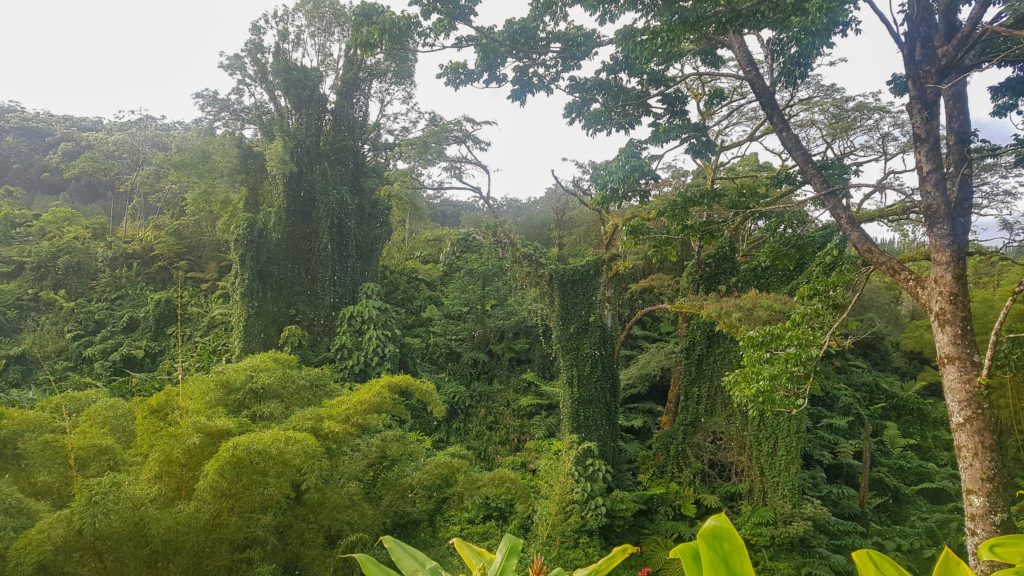
Read next:
The Thorough Guide to Kailua-Kona, Hawaii
Everything you need to know about visiting Hawai’i Volcanoes National Park, Hawaii
Everything you need to know about visiting Punalu’u Black Sand Beach, Hawaii
Everything you need to know about visiting Pu’uhonua O Hōnaunau National Historical Park, Hawaii
The Thorough Guide to Snorkelling on Hawaii’s Big Island
